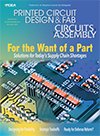Features Articles
Using Lean Six Sigma to prioritize projects, optimize capex, and inform employee recognition.
Lean Six Sigma is a powerful tool for production teams committed to continuous improvement. Viewed as individual activities, however, the overall impact of the improvements it drives may not be obvious. The Continuous Improvement teams in SigmaTron International’s Tijuana, Mexico, facility address this with an annual review meeting that looks both at accomplishments over the past year and year-over-year trends. The top three teams are recognized for their accomplishments.
Watch out for the one who lives to throw a wrench in the works.
I have this idea. Rather than having the nuclear codes reside in the White House, they should embed with the American people on a rotating basis. Not unlike the Stanley Cup, which overnights in each offseason residence of the members of the NHL championship team. Do the same with the car keys to obliteration; move them from place to place nightly. Think of the possibilities: who will have the effrontery to keep up with the Joneses, especially when they have the power to unleash Armageddon with one push of a button? There goes the neighborhood, indeed. Think twice before criticizing their taste in wainscoting. Consider if the nuclear football kicked off in a house with Polish heritage and a long memory, still seething over the “stolen” Russian win in the gold medal game of the 1972 Olympic basketball tournament. Revenge is a dish best served with beer and hors d’oeuvres, watching live cable, and Poles do not fancy Russians. Talk about checks and balances. What could possibly go wrong with this exercise of grassroots democracy?
 Industry-wide security efforts could benefit from a smaller, more agile approach.
Industry-wide security efforts could benefit from a smaller, more agile approach.
One of the major trends, or more specifically, major needs, over the past decade is the quest to beef up security methods and protocols to protect intellectual property (IP) and secure the numerous long and global supply chains. As with any emerging trend, opinions are varied as to exactly what “security” means, as well as how to best define “supply chain.”
Over the past quarter century, the global supply chain has grown, prospered and become increasingly complex. The flourishing of such a complex and efficient manufacturing environment has required deployment of advanced technology – not just in how product is manufactured on the production floor but also in how data are transferred. Data include everything from Controlled Unclassified Information (CUI) to all the myriad details required to logistically make sure items and sub-items are shipped and arrive in time – anywhere in the world – at the required location for assembly. This is where the concept of security gets interesting.
 A top-down strategy is needed to change course.
A top-down strategy is needed to change course.
Both the Trump and Biden administrations have taken significant steps to bring manufacturing back to the United States. But realistically, when will this goal become feasible, and at what cost?
For domestic PCB buyers who currently rely on Asia for production, how much longer will they need to shoulder the burden of tariffs for boards that cannot be produced in the US within a reasonable timeframe?
In late May last year, the US Trade Representative announced another one-year reprieve from the 25% tariff on two- and four-layer rigid printed circuit boards. While this exemption applies to only a narrow portion of PCBs manufactured in China, it provides some relief to OEMs and EMS companies facing severe supply chain challenges. This short-term measure, however, does little to address the broader issues of manufacturing capacity and technological capability in the US.
 Leveraging local and state stakeholders for future growth.
Leveraging local and state stakeholders for future growth.
One positive of the last election is that the Trump administration is pro-US manufacturing and is considering tax incentives to reward companies that manufacture in the US and tariffs to punish countries restricting US-made goods. That creates both opportunities and challenges for the electronics manufacturing services (EMS) industry.
Tariff policy is definitely a looming challenge. The earlier China tariffs had the net effect of driving production to Mexico since components imported into Mexico were typically not subject to tariffs and could be reimported without duties once transformed in Mexican-made products. That may change, as Chinese companies have invested heavily in Mexican manufacturing to avoid tariffs. Tariffs may also impact the attractiveness of facilities in countries subject to them.
 Planning for future updates can save customers a headache.
Planning for future updates can save customers a headache.
“Unplanned obsolescence” can happen to a PCB, so the printed circuit board designer must provide a few hooks to give the project a second chance.
Once upon a time, car stereos were almost universally interchangeable, so you could get a new, improved one off the shelf from your local specialty store. Upgrading car sound systems was my “side hustle” as a teenager. There were no how-to videos back then, but there are now.
That’s because it’s necessary! For my car, it starts with vents and the display screen at the top of the center stack and works through the HVAC control module. Then, you can pull the infotainment system out and hope it all clicks back into place afterwards. Who’s got time for that? (Life in the auto repair trade.)
No user-serviceable parts inside? Give me a break! The head unit is tough to get to, but the PCBs within the chassis use active components in quad-flatpack (QFP) packages rather than ball grid array (BGA) packages, which are more difficult, but certainly not impossible, to solder or desolder. The QFP’s perimeter pins are more accessible for the do-it-yourselfer. Functionally, these circuits provide entertainment to the driver, which is unrelated to safety, so a Class 2 PCB should be fine. Still, the BGA package is avoided as it doesn’t fit the high-reliability mindset of the auto industry. QFP devices permit more robust Class 3 circuit boards if the voice navigation aspect is considered a vital system and integrated with the audio.
Press Releases
- Altus Group Expands Aftersales Team to Its Largest Size to Date
- Incap Estonia Invests in New Flying robe System to Advance Production Performance
- Critical Manufacturing Partners with Canonical to Expand Cloud-Native Deployment Options for Manufacturers
- Heller Industries Becomes the Latest Partner to Join THE SMT FUTURE EXPERIENCE


